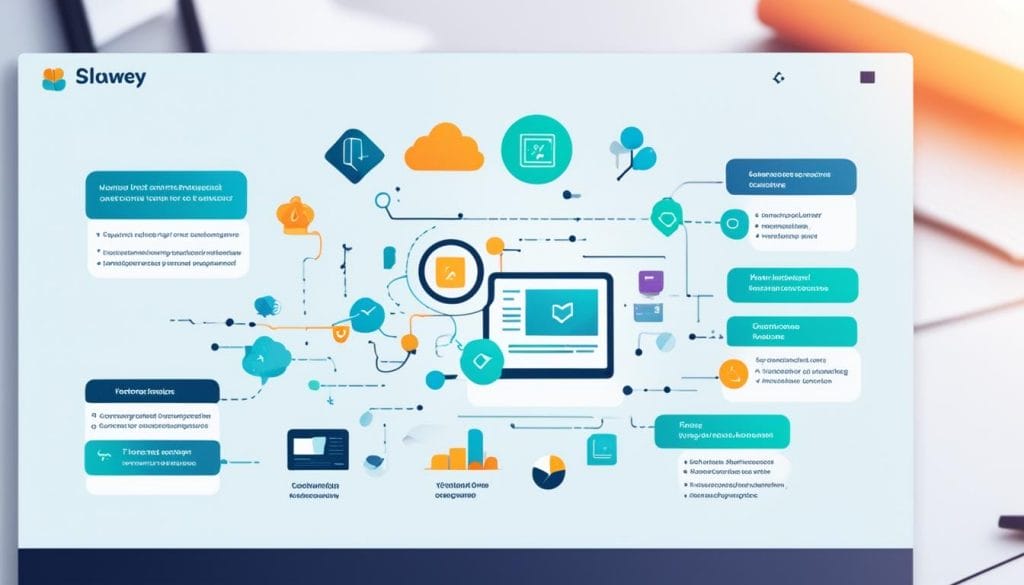Did you know that about 70% of learners feel more engaged in blended learning than in traditional classrooms? This shows how mixing old-school teaching with new digital ways changes education. Now, having good Learning Management Systems (LMS) is key. They help mix online tools with training to make learning better in today’s diverse world.
Blended learning combines in-person teaching with online tools for a better learning experience. This guide will look at what blended learning is and how Learning Management Systems help make education better.
Key Takeaways
- Blended learning makes students more engaged and improves their learning.
- Learning management systems make teaching easier.
- Online tools make learning available to more people.
- Digital platforms offer learning that fits each student’s needs.
- Having a clear plan is key to successful blended learning.
Understanding Blended Learning
Blended learning combines traditional classroom teaching with online elements. This approach creates a rich and flexible learning space for students. It uses different teaching methods to give each student a personalized experience. Knowing the basics of blended learning is key as education changes.
Definition and Key Components
Blended learning includes both synchronous and asynchronous learning. Synchronous learning happens in real-time, letting students talk with teachers and peers directly. Asynchronous learning lets students learn at their own pace. Key parts of this model are:
- Face-to-face classroom sessions
- Online learning modules and webinars
- Interactive assessments
- Use of e-learning management systems for tracking progress
These parts mix to make hybrid learning solutions that meet different learning needs and likes.
Benefits of Blended Learning
Blended learning has big benefits for teachers and students. Key advantages are:
- Increased accessibility for learners in different places.
- The chance to tailor education to various learning styles.
- Better student engagement with different teaching methods.
- Less use of resources for schools using blended learning platforms.
Overall, blended learning offers a flexible way to learn that meets students’ changing needs. For more details, check out a detailed look at blended learning here.
Why Move to Blended Learning?
The move to blended learning is key today, thanks to modern education needs. Schools now aim to offer learning experiences that fit everyone’s needs. This approach mixes old-school teaching with new tech, making learning fit today’s standards.
Adapting to Modern Educational Needs
Remote work and digital tech are changing how we teach. Schools use remote learning management to offer flexible training. This lets learners get course materials on any device, helping them learn at their own speed.
This flexibility keeps schools up-to-date and effective. It helps them meet the growing need for learning that’s tailored to each student.
Maximizing Training Efficiency and Accessibility
Blended learning makes training more efficient, cutting down on time and costs. It lets organizations use resources better and get more people involved. Plus, it makes sure everyone can join in, no matter where they are.
For instance, tools like no-code metaverse builders are great for big training needs. They make creating virtual experiences easy and improve the learning experience. They also work well on different devices. To see what’s available, check out Hyperspace.
Learning Management Systems in Blended Learning
Learning Management Systems (LMS) are key in education, especially in blended learning. They connect online learning with in-person classes. This makes learning organized and helps students stay on track.
What is a Learning Management System (LMS)?
A Learning Management System is a software that helps plan, deliver, and check student progress in courses. It makes teaching easier and focuses on the student’s experience. Teachers can keep track of student progress and give tests easily.
Role of an LMS in Blended Learning
In blended learning, an LMS does more than just share content. It has many features, like:
- Centralized repository for course materials
- Integration of virtual classroom technology for real-time instruction
- Tools for monitoring learner engagement and performance
- Offering interactive components like quizzes and discussion forums
With these tools, teachers can mix traditional teaching with online learning. This approach makes learning more engaging and helps students learn at their own pace.
Types of Blended Learning Models

It’s key to know the different blended learning models for good teaching methods. Hybrid learning and the flipped classroom are two main ways. They both aim to make learning better.
Hybrid Learning Models
Hybrid models mix online and in-person teaching for flexible learning. Teachers can tailor lessons to what students need. Students might work on online tasks at their own speed and then meet in class for discussions.
This way, everyone learns in a way that fits them best. It makes learning more interactive and helps teachers teach better.
Flipped Classroom Approach
The flipped classroom changes how we teach. Students look at online materials before class. Then, class time is for talking, working together, and doing hands-on activities.
This method gets students more involved and lets them learn in a way that suits them. It helps them understand better by applying what they learned online.
Best Practices for Implementing Blended Learning
Starting blended learning needs careful planning. It’s key to have clear learning goals. These goals help guide both teachers and students through the process.
Identifying Learning Objectives
Before starting e-learning, teachers must set clear goals. This is vital for effective blended learning. Goals should be SMART: specific, measurable, achievable, relevant, and time-bound.
Having clear goals helps teachers make content that teaches and motivates. It makes sure the learning is focused and engaging.
Integrating Different Learning Modalities
Adding different ways to learn makes blended learning richer. Using videos, quizzes, and live discussions creates engaging interactions. This mix keeps students interested and helps them remember what they learn.
Using engaging ways to deliver content boosts student participation and retention. This means students can understand and remember information better.
| Element | Purpose | Benefit |
|---|---|---|
| Clear Objectives | Guide learning paths | Enhanced focus and direction |
| Videos | Introduce concepts | Visual engagement and information retention |
| Quizzes | Assess understanding | Immediate feedback and self-evaluation |
| Real-time Discussions | Foster collaboration | Build community and deeper understanding |
Key Features to Look for in LMS Software

Choosing the right Learning Management System (LMS) is key to making blended learning work well. It’s important to focus on certain LMS software features for a better learning experience. Look for these key elements to boost learner engagement and teaching efficiency.
Usability and User Experience
A user-friendly design is crucial in any LMS. The platform should be easy for learners and teachers to use. It should have features that make learning smooth, such as:
- Simple and clear layout
- Mobile accessibility for learning on-the-go
- Customizable dashboards for personalized user experience
Tracking and Reporting Capabilities
Being able to track and analyze how students interact and perform is key. Tracking learner progress helps teachers see what’s working. Important features include:
- Detailed performance analytics
- Dashboard for real-time progress updates
- Automated reporting for easy sharing of insights
Popular Blended Learning Platforms
Organizations looking to blend learning should check out popular LMS platforms. Each platform has unique features for different learning needs. It’s key to look closely at these options.
Overview of Top LMS Solutions
Some top platforms that catch the eye include:
- TalentLMS: Known for its easy-to-use interface and lots of customization.
- LearnUpon: Has strong tools for tracking learner progress and handling various training.
- iSpring: Famous for its tools that make creating content easier.
Comparative Analysis of Pricing Models
Knowing the pricing for LMS software is key for matching budget with features. It’s smart to look at different pricing plans:
| LMS Platform | Pricing Model | Starting Price |
|---|---|---|
| TalentLMS | Subscription-based | $59/month |
| LearnUpon | Custom pricing based on users | Contact for details |
| iSpring | One-time licensing | $970 one-time fee |
These e-learning management systems comparisons help find the right fit for budget and learning goals. It’s vital to look at both features and costs before deciding.
Creating Engaging Content for Blended Learning
Making content engaging is key in blended learning. It helps keep learners motivated and interested. By using tools like videos, infographics, and quizzes, teachers can make learning fun and interactive. This way, students enjoy learning more and get involved.
Utilizing Multimedia and Interactive Tools
Using multimedia is important for engaging content. Interactive tools help with teamwork and thinking skills. For example, simulations and games make lessons more real and fun.
Platforms like Duolingo use technology to make learning languages fun. They offer adaptive learning experiences that help learners a lot.
Ensuring Accessibility for All Learners
It’s also vital to make learning accessible for everyone. This means making sure all learners can use the materials. Teachers can do this by adding features like screen readers and big fonts.
By using different types of content and focusing on accessibility, teachers can make sure all students succeed. For more ideas on new ways to learn languages, check out this resource.
FAQ
What is blended learning?
Blended learning mixes traditional teaching with online learning. It uses LMS software for a well-rounded learning experience. Students get both in-person and online learning chances.
How does a Learning Management System (LMS) function in blended learning?
An LMS is key for planning and tracking blended learning programs. It blends online and in-person learning. This approach uses tools like games and analytics to keep students engaged.
What are the benefits of using blended learning platforms?
Blended learning platforms offer more access and personalized learning. They save resources and make training more efficient. Students can learn anytime, anywhere.
What makes hybrid learning different from other blended learning models?
Hybrid learning offers flexible learning settings. It combines online and in-person learning. This approach encourages teamwork and customized learning.
Why is effective content creation important in blended learning?
Good content keeps learners interested and helps them remember more. Using videos, infographics, and interactive tools makes learning rich and effective.
What features should I look for when selecting an LMS?
Look for an LMS that’s easy to use and works on mobiles. It should track and report on learning well. These features make learning better and easier to manage.
How does blended learning adapt to modern educational needs?
Blended learning meets today’s learning needs by using online tools and flexible training. It suits the fast pace of today’s learning.
What are the different types of blended learning models available?
There are many blended learning models. Hybrid learning is flexible, and the flipped classroom uses online content before in-person sessions. This approach encourages hands-on learning.
How can institutions ensure accessibility in blended learning?
Schools can make learning accessible by using tools for different learning needs. They should offer multimedia tools and content in various formats.
How do different LMS platforms compare in terms of pricing?
LMS platforms have different pricing, like subscription or one-time fees. Solutions like TalentLMS, LearnUpon, and iSpring offer various options. Schools should compare them to find the best fit for their budget and goals.





